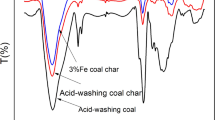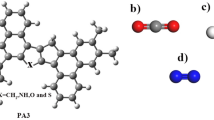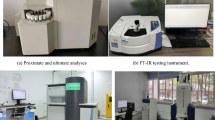Abstract
Coal is the United States' most abundant nonrenewable energy resource. However, the quality of many coals is too low to offset the practical, economic, and regulatory barriers to their utilization. A variety of bacterial and fungal species have been shown to attack low rank (i.e., low–quality) coals. Technologies based on these microbial activities may be useful for the conversion of these coals to more useful products, including high–quality fuels and chemicals. Substantial developmental work will be required in order for these microbial processes to become competitive with nonbiological processes. This review summarizes the microbiological and biochemical principles underlying microbial coal conversion as a basis for predicting the practical utility of coal bio–processes.
This is a preview of subscription content, access via your institution
Access options
Subscribe to this journal
Receive 12 print issues and online access
$209.00 per year
only $17.42 per issue
Buy this article
- Purchase on Springer Link
- Instant access to full article PDF
Prices may be subject to local taxes which are calculated during checkout
Similar content being viewed by others
References
Energy Information Administration. 1990. Monthly Energy Review, June 1991, U.S. Dept. of Energy Report No. DOE/EIA-0035(91/06), Washington.
Hagan, C.W., Jr. 1989. Energy Technology R&D: What Could Make a Difference? Oak Ridge Nat. Lab. Report No. 6541/v1, Oak Ridge, TN
Meyers, R.A. (Ed.) 1981. Coal Handbook, Marcel Dekker, Inc., New York.
Berkowitz, N., 1985. Chemistry of Coal, Elsevier, Amsterdam.
Hessley, R.K., Reasoner, J.W. and Riley, J.T. 1986 Coal Science: An Introduction to Chemistry, Technology, and Utilization, John Wiley & Sons, New York.
Couch, G.R. 1987. Biotechnology and coal. IEA Coal Res. Rep. ICTIS/TR38, (56 pp.).
Shepard, M. 1987. Bugs and coal: processing fuels with biotechnology. EPRI J. 12: 28–35.
Srivastava, R.D., Campbell, I.M. and Blaustein, B.D. 1989. Coal bioprocessing: a research-needs assessment. Chem. Eng. Prog. 85: 45–53.
Faison, B.D. 1991 The chemistry of low rank coals and its relation ship to the biochemical mechanisms of coal biotransformation. In: Microbial Transformations of Low Rank Coals, Crawford, D. L. (Ed.). CRC Press, Inc., Boca Raton. In press
Schobert, H.H. 1990. Structural features of low-rank coals. Resources Conserv. Recycling 3: 111–115.
Rogoff, M.H., Wander, I. and Anderson, R.G. 1962. Microbiology of Coal. U.S. Dept. of Interior Bureau of Mines Information Circular No. 8075, Washington
Korburger, J.A. 1964. Microbiology of coal: growth of bacteria in plain and oxidized coal slurries. Proc. W. Virginia Acad. Sci. 36: 26–30.
Schenk, N.C. and Carter, J.C. 1954. A fungistatic substance extracted from vitrain. Science 119: 213.
Kosanke, R.M. 1954. A bacteriostatic substance extracted from vitrain ingredient of coal. Science 119: 214.
Olsson, G., Larsson, L., Holst, O. and Karlsson, H.T. 1989. Microorganisms for the desulphurization of coal: the influence of leaching compounds on their growth. Fuel 68: 1270–1272.
Cohen, M.S. and Gabriele, P.D. 1982. Degradation of coal by the fungi Polyporus versicolor and Poria monticola. Appl. Environ. Microbiol. 44: 23–27.
Fakoussa, R. M. and Truper, H. G. 1983. Kohle als Microbielles Substrat unter Aeroben Bedingungen [Coal as substrate for microorganisms: investigations of the microbial decomposition of untreated hard coals], p. 41–49. In: Kolloquium in der Berbbau-Forschung GmbH. Rehm, H.J. (Ed.). Steinkohlenbergbauverein, Essen, FRG.
Ward, B. and Sanders, A. 1990. Solubilization of lignites by fungi, p 3/57–68. In: Proc. Electric Power Research Institute Symp. on the Biological Processing of Coal and Coal-Derived Substances, Electric Power Research Institute, Palo Alto, CA.
Ward, B. 1985. Lignite-degrading fungi isolated from a weathered outcrop. System. Appl. Microbiol. 6: 236–238.
Scott, C.D., Strandberg, G.W. and Lewis, S.N. 1986.Microbial solubilization of coal. Biotechnol. Prog. 2: 131–139.
Gupta, R.K., Spiker, J.K. and Crawford, D.L. 1988. Biotransformation of coal by ligninolytic Streptomyces. Can. J. Microbiol. 34: 667–674.
Strandberg, G.W. and Lewis, S.N. 1987. Solubilization of coal by an extracellular product from Streptomyces setonii75Vi2. J. Indus. Microbiol. 1: 371–375.
Quigley, D.R., Ward, B., Crawford, D.L., Hatcher, H.J. and Dugan, P.R. 1989. Evidence that microbially produced alkaline materials are involved in coal biosolubilization. Appl. Biochem. Biotechnol. 20/21: 753–764.
Runnion, K. and Combie, J.D. 1990. Thermophilic microorganisms for coal biosolubilization. Appl. Biochem. Biotechnol. 24/25: 817–829.
Ward, B., Quigley, D.R. and Dugan, P.R. 1988. Relationships between natural weathering and lignite biosolubility or alkali solubility, p. 40–46. In: Proc. Institute for Gas Technology Conference on Coal, Institute for Gas Technology, Chicago, IL.
Strandberg, G.W. and Lewis, S.N. 1987. A method to enhance the microbial liquefaction of lignite coals. Biotechnol. Bioeng. Symp. 17: 153–158.
Stewart, D.L., Thomas, B.L., Bean, R.M. and Fredrickson, J.K. 1990. Colonization and degradation of oxidized bituminous coal by Penicillium sp. J. Indus. Microbiol. 6: 53–58.
Maka, A., Srivastava, V.J., Kilbane, J.J., II and Akin, C. 1989. Biological solubilization of untreated North Dakota lignite by a mixed bacterial and a mixed bacterial/fungal culture. Appl. Biochem. Biotechnol. 20/21: 715–730.
Quigley, D.R., Wey, J.E., Breckenridge, C.R., Stoner, D.L. and Dugan, P.R. 1987. Comparison of products obtained by alkali and microbial solubilization of coal, p. 315–323. In: Processing and Utilization of High Sulfur Coals II, Chugh, Y. P. and Caudle, R. D.(Eds.). Elsevier Science Publishing Co., New York.
Cohen, M.S., Bowers, W.C., Aronson, H. and Gray, E.T., Jr. 1987. Cell-free solubilization of coal by Polyporus versicolor. Appl. Environ. Microbiol. 53: 2840–2843.
Strandberg, G.W. and Lewis, S.N. 1988. Factors affecting coal solubilization by the bacterium Streptomyces setonii 75Vi2 and by alkaline buffers. Appl. Biochem. Biotechnol. 18: 355–362.
Quigley, D.R., Breckenridge, C.R. and Dugan, P.R. 1989. Effects of multivalent cations on low-rank coal solubilities in alkaline solutions and microbial cultures. Energy Fuels 3: 571–574.
Do Nascimento, H.C.G., Lee, K.I., Chou, S.-Y., Wang, W.-C., Chen, J.R. and Yen, T.F. 1987. Growth of Polyporus versicoloron lignite fractions. Process Biochem. 22: 24.
Quigley, C.R., Wey, J.E., Breckenridge, C.R. and Stoner, D.L. 1988. The influence of pH on biological solubilization of oxidized, low-rank coal. Resources Conserv. Recycling 1: 163–172.
Fakoussa, R.M. 1989. Comparison of the mechanisms of lignite and hard coal degradation by microorganisms, p. 330–348. In: Proc. Bioprocessing of Fossil Fuels Workshop, U.S. Dept of Energy, Washington.
Faison, B.D. and Lewis, S.N. 1989. Production of coal-solubilizing activity by Paecilomyces sp. during submerged growth in defined liquid media. Appl. Biochem. Biotechnol. 20/21: 743–752.
Cohen, M.S., Feldman, K.A., Brown, C.S. and Gray, E.T., Jr. 1990. Isolation and identification of the coal-solubilizing agent produced by Trametes versicolor. Appl. Environ. Microbiol. 56: 3285–3294.
Faison, B.D., Woodward, C.A. and Bean, R.M. 1990. Microbial solubilization of a preoxidized subbituminous coal: product characterization. Appl. Biochem. Biotechnol. 24/25: 831–836.
Linehan, J.C. 1991. Characterization of the coal biosolubilization process using gel permeation chromatography and CPMAS NMR, p. 1/73–86. In: Proc. 1st Int. Symp. on the Biological Processing of Coal, Electric Power Research Institute, Palo Alto, CA. In press.
Pyne, J.W., Jr., Stewart, D.L., Fredrickson, J. and Wilson, B.W. 1987. Solubilization of leonardite by an extracellular fraction from Coriolus versicolor. Appl. Environ. Microbiol. 53: 2844–2848.
Moolick, R.T., Karim, M.N., Linden, J.C. and Burback, B.L. 1889. Lignite solubilizauon by cell-broths of Penicillium cultures. Presented at the llth Symp. on Biote technology for Fuels and Chemicals, Colorado Springs, CO.
Scott, C.D. and Lewis, S.N. 1988. Biological solubilization of coal using both in vivo and in vitro processes. Appl. Biochem. Biotechnol. 18: 403–409.
Scott, C.D., Woodward, C.A., Thompson, J.E. and Blankinship, S.L. 1990. Coal solubilization by enhanced enzyme activity in organic solvents. Appl. Biochem. Biotechnol. 24/25: 799–815.
Crawford, D.L., Gupta, R.K., Deobald, L.A. and Roberts, D.J. 1990. Biotransformations of coal and coal substructure model compounds by bacteria under aerobic and anaerobic conditions, p. 4/27–44. In: Proc. 1st Int. Symp. on the Biological Processing of Coal, Electric Power Research Institute, Palo Alto, CA.
Crawford, D.L. 1991. Extracellular enzymes produced by a coal depolymerizing bacterium under induced and uninduced growth conditions. Presented at the 2nd Int. Symp. on the Biological Processing of Coal, San Diego, CA
Wondrack, L., Szanto, M. and Wood, W.A. 1989. Depolymerization of water soluble coal polymer from subbituminous coal and lignite by lignin peroxidase. Appl. Biochem. Biotechnol. 20/21: 765–780.
Gupta, R.K., Deobald, L.A. and Crawford, D.L. 1990. Depolymerization of lignite coal by Pseudomonas strain 07. Appl. Biochem. Bio technol. 24/25: 899–907.
Campbell, J.A., Stewart, D.L., McCulloch, M., Lucke, R.B. and Bean, R.M. 1990. Biodegradation of coal-related model compounds. Amer. Chem. Soc. Div. Fuel Chem. 33: 514–518.
Davison, B.H., Nicklaus, D.M., Misra, A., Lewis, S.N. and Faison, B.D. 1990. Utilization of microbially solubilized coal: Preliminary studies on aerobic conversion. Appl. Biochem. Biotechnol. 24/25: 447–456.
Ackerson, M.D., Johnson, N.L., Ile, M., Clausen, E.C. and Gaddy, J.L. 1990. Biosolubilization and liquid fuel production from coal. Appl. Biochem. Biotechnol. 24/25: 913–922.
Borgmeyer, J.R. and Crawford, D.L. 1985. Production and characterization of polymeric lignin degradation intermediates from two different Streptomyces species. Appl. Environ. Microbiol. 49: 273–278.
Crawford, D.L., Pometto, A.L., III and Crawford, R.L. 1985. Production of useful modified lignin polymers by bioconversion of lignocellulose with Streptomyces. Biotechnol. Adv. 2: 217–232.
Crawford, D.L., Pettey, T.M., Thede, B.M. and Deobald, L.A. 1984. Genetic manipulation of ligninolytic Streptomyces and generation of improved lignin-to-chemical bioconversion strains. Biotechnol. Bio eng. Symp. 14: 241–256.
Barik, S., Wyza, R. and Isbister, J.D. 1990. Biological conversions of low-rank coals, p. 5/19–32. In: Proc. Electric Power Research Institute Symp. on the Biological Processing of Coal and Coal-Derived Sub stances. Electric Power Research Institute, Palo Alto, CA.
Andrews, G. 1991. Mass and energy balance constraints on the biological production of chemicals from coal. Fuel 70: 569–575.
Jain, M.K. 1991. Biodecarboxylation of subbituminous coal under anaerobic conditions. Presented at the 2nd Int. Symp. on the Biological Processing of Coal, San Diego, CA.
Aleem, M.I.A. 1991 Bioprocessing of coal: microbial hydrogenation of coal and effect of liquefaction. Presented at the 2nd Int. Symp. on the Biological Processing of Coal, San Diego, CA.
Faison, B.D., Clark, T.M., Lewis, S.N., Ma, C.Y., Sharkey, D.M. and Woodward, C.A. 1991 Degradation of organic sulfur compounds by a coal solubilizing fungus. Appl. Biochem. Biotechnol. 28/29: 237–251.
Author information
Authors and Affiliations
Rights and permissions
About this article
Cite this article
Faison, B. Microbial Conversions of Low Rank Coals. Nat Biotechnol 9, 951–956 (1991). https://doi.org/10.1038/nbt1091-951
Issue Date:
DOI: https://doi.org/10.1038/nbt1091-951
This article is cited by
-
Facultative-anaerobic microbial digestion of coal preparation waste and use of effluent solids to enhance plant growth in a sandy soil
International Journal of Coal Science & Technology (2021)
-
Biodepolymerization studies of low rank Indian coals
World Journal of Microbiology and Biotechnology (2009)
-
Biotechnology: Its place in geography
GeoJournal (1993)
-
Microbial Conversions of Low Rank Coals
Bio/Technology (1991)



